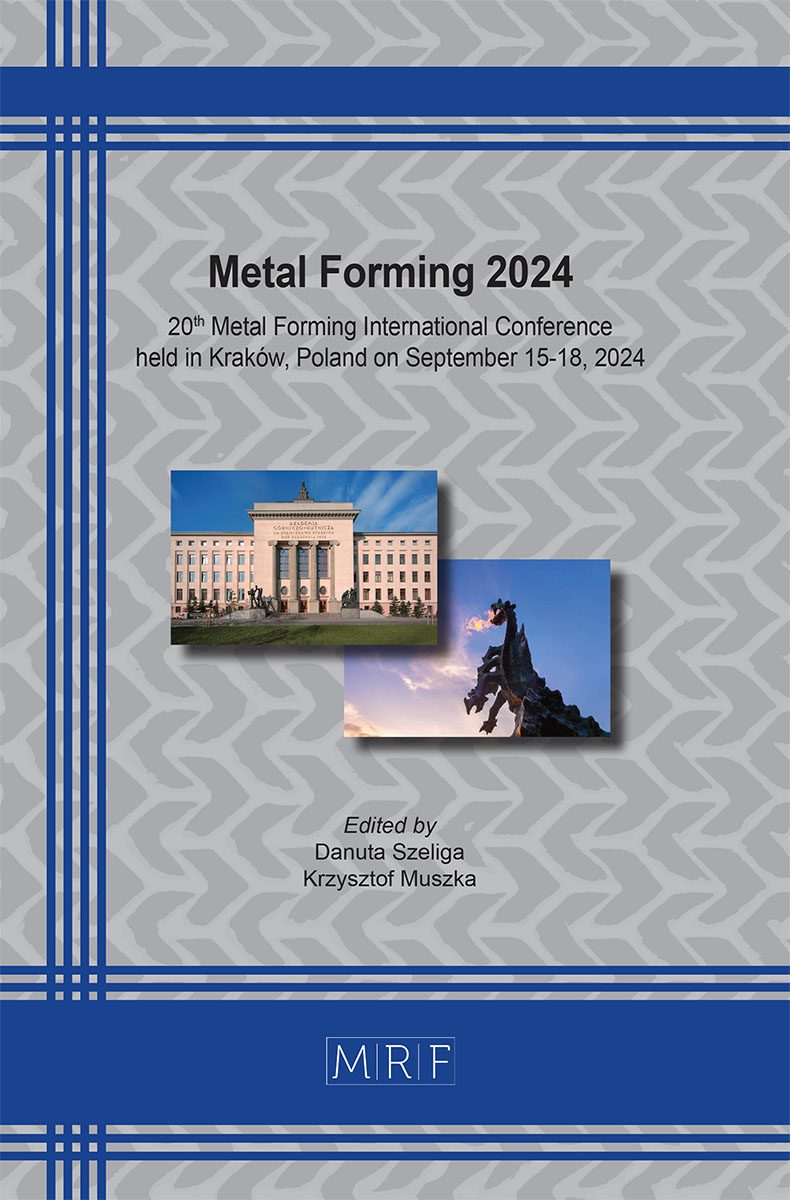–
Development of unified constitutive model for hot deformation behavior of TC4 with and without diffusion bonding
CAI Zhongman, CHEN Haosheng, LI Can, CHEN Jiarui, LI Xiaoxing, LI Yong
download PDFAbstract. The hot deformation behavior of TC4 with and without diffusion bonding (DB) is studied. Firstly, the hot tensile testes of TC4 specimens with and without DB were carried out at temperature of 750℃ and strain rate of 0.1 ~ 0.0001 s-1. It was found that the peak stress and fracture strain of DB specimens are lower than those of base metal (BM) specimens. The quasi-cleavage fracture appeared in the DB specimens at 750℃, and the mechanism could be explained as straight grain boundary formed by incomplete recrystallization and insufficient grain boundary migration energy and the joints weak left over from the DB process causing rapid voids nucleation at the DB interface. The shorter distance of voids coalescence within the interface leads to quasi-cleavage fracture. In addition, a unified constitutive model based on internal variables was developed by introducing the weld-dependent fracture coefficients and damage tolerance coefficient. The model can accurately predict the hot deformation behavior of TC4 with and without diffusion bonding, describing the influence behavior of DB area on hot deformation, as well as the evolutions of internal variables, including dislocation density, reserve fraction, dynamic recrystallization (DRX) fraction and damage. It provides a theoretical basis for further accurate simulation of the hot forming of titanium alloy with diffusion bonding.
Keywords
TC4, Hot Deformation, Modeling, Diffusion Bonding
Published online 9/15/2024, 10 pages
Copyright © 2024 by the author(s)
Published under license by Materials Research Forum LLC., Millersville PA, USA
Citation: CAI Zhongman, CHEN Haosheng, LI Can, CHEN Jiarui, LI Xiaoxing, LI Yong, Development of unified constitutive model for hot deformation behavior of TC4 with and without diffusion bonding, Materials Research Proceedings, Vol. 44, pp 548-557, 2024
DOI: https://doi.org/10.21741/9781644903254-59
The article was published as article 59 of the book Metal Forming 2024
![]() Content from this work may be used under the terms of the Creative Commons Attribution 3.0 license. Any further distribution of this work must maintain attribution to the author(s) and the title of the work, journal citation and DOI.
Content from this work may be used under the terms of the Creative Commons Attribution 3.0 license. Any further distribution of this work must maintain attribution to the author(s) and the title of the work, journal citation and DOI.
References
[1] K. Zheng, D. Li, H. Chen, S. Qu, Z. Zhao, Y. Zhang, Y. Li, Effect of cooling rate on the phase transformation and post strength of Ti-6Al-4V under hot forming conditions: Experiments and modelling, J. Alloy. Compd. 972 (2024) 172868. https://doi.org/10.1016/j.jallcom.2023.172868
[2] Y. Li, H. Chen, L. Du, F. Yang, Y. Zhang, D. Li, Characterization and unified modelling of creep and viscoplasticity deformation of titanium alloy at elevated temperature, Int. J. Plast. (2024) 103892. https://doi.org/10.1016/j.ijplas.2024.103892
[3] C. Li, Y. Li, D. Zhang, X. Li, W. Zhao, Experimental investigation of the mechanical properties and microstructures of Ti–6Al–4V solid-state diffusion bonding joint under high temperature conditions, J. Mater. Res. Technol. 26 (2023) 4042-4058. https://doi.org/10.1016/j.jmrt.2023.08.172
[4] S.V.S. Narayana Murty, B. Nageswara Rao, B.P. Kashyap, Processing maps for hot deformation of α2 aluminide alloy Ti-24Al-11Nb, J. Mater. Sci. 37 (2002) 1197-1201. https://doi.org/10.1023/A:1014323723598
[5] Y. Peng, J. Li, Z. Li, S. Li, W. Guo, X. Gao, J. Xiong, Interfacial voids and microstructure evolution, bonding behavior and deformation mechanism of TC4 diffusion bonded joints, J. Manuf. Process. 81 (2022) 837-851.
[6] S.M. Imran, C. Li, L. Lang, Y. Guo, H.A. Mirza, F. Haq, S. Alexandrova, J. Jiang, H. Han, An investigation into Arrhenius type constitutive models to predict complex hot deformation behavior of TC4 alloy having bimodal microstructure, Materials Today Commun. 31 (2022) 103622. https://doi.org/10.1016/j.mtcomm.2022.103622
[7] C. Li, I. Sardar Muhammad, L. Lang, Y. Guo, X. Li, S. Alexandrova, D. Zhang, Hot deformation behavior and strain compensation constitutive model of equiaxed fine grain diffusion-welded micro-duplex TC4 titanium alloy, Chinese J. Aeronautics 36 (2023) 510-522. https://doi.org/10.1016/j.cja.2022.07.025
[8] E. Alabort, D. Putman, R.C. Reed, Superplasticity in Ti–6Al–4V: Characterisation, modelling and applications, Acta Mater. 95 (2015) 428-442. https://doi.org/10.1016/j.actamat.2015.04.056
[9] D. Wu, K. Wang, B. Liu, H. Qu, X. Wang, G. Liu, Damage evolution of titanium alloy laser-welded joint during hot deformation: Experiment and modeling, J. Mater. Res. Technol. 26 (2023) 6375-6388. https://doi.org/10.1016/j.jmrt.2023.09.023
[10] B.H. Cheong, J. Lin, A.A. Ball, Modelling of hardening due to grain growth for a superplastic alloy, J. Mater. Process. Technol. 119 (2001) 361-365. https://doi.org/10.1016/S0924-0136(01)00929-3
[11] Q. Bai, J. Lin, T.A. Dean, D.S. Balint, T. Gao, Z. Zhang, Modelling of dominant softening mechanisms for Ti-6Al-4V in steady state hot forming conditions, Mater. Sci. Eng. A 559 (2013) 352-358. https://doi.org/10.1016/j.msea.2012.08.110
[12] Y. Estrin, Dislocation theory based constitutive modelling: foundations and applications, J. Mater. Process. Technol. 80-81 (1998) 33-39. https://doi.org/10.1016/S0924-0136(98)00208-8
[13] Y. Wu, D. Wang, Z. Liu, G. Liu, A unified internal state variable material model for Ti2AlNb-alloy and its applications in hot gas forming, Int. J. Mech. Sci. 164 (2019) 105126. https://doi.org/10.1016/j.ijmecsci.2019.105126
[14] Y. Huo, J. Lin, Q. Bai, B. Wang, X. Tang, H. Ji, Prediction of microstructure and ductile damage of a high-speed railway axle steel during cross wedge rolling, J. Mater. Process. Technol. 239 (2017) 359-369. https://doi.org/10.1016/j.jmatprotec.2016.09.001
[15] L. Zhao, T. Yasmeen, P. Gao, S. Wei, Z. Bai, J. Jiang, J. Lin, Mechanism-based constitutive equations for superplastic forming of TA15 with equiaxed fine grain structure, Procedia Eng. 207 (2017) 1874-1879. https://doi.org/10.1016/j.proeng.2017.10.954
[16] M.A. Greenfield, H. Margolin, The mechanism of void formation, void growth, and tensile fracture in an alloy consisting of two ductile phases, Metall. Mater. Trans. B 3 (1972) 2649-2659. https://doi.org/10.1007/BF02644241
[17] J. Cao, J. Lin, A study on formulation of objective functions for determining material models, Int. J. Mech. Sci. 50 (2008) 193-204. https://doi.org/10.1016/j.ijmecsci.2007.07.003












